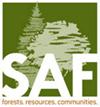Chemical Site Preparation Mixtures, Application Timing, and Herbaceous Weed Control Impacts on Loblolly Pine Development Through Six Years
IF 1.5
4区 农林科学
Q2 FORESTRY
引用次数: 0
Abstract
Chemical site preparation is a critical management practice for southern pine plantation establishment. Imazapyr and ester triclopyr are frequently used for chemical site preparation in the Lower Coastal Plain to control waxy leaf shrub species, yet limited information is available on optimal imazapyr and triclopyr tank mixes and individual herbicide application timing(s) to achieve maximum loblolly pine (Pinus taeda L.) growth. The objectives of this study were to determine the survival, growth, and stem defect response of 6-year-old loblolly pine to four chemical site preparation treatments plus an untreated control, three application timings, and first year herbaceous weed control (hwc) on a poorly drained flatwoods site. Treatments included two imazapyr and triclopyr rates applied as tank mixes, triclopyr and imazapyr alone, and an untreated control with hwc applied to half of each treatment plot. Results showed no treatment had superior survival or growth, whereas September-applied imazapyr and triclopyr tank mixes tended to result in improved growth. Triclopyr alone along with first year, banded hwc resulted in similar growth to imazapyr and triclopyr tank mixes. First-year hwc significantly enhanced survival and growth. Stem defects were more common in the chemical site preparation treatments than the control. Study Implications: Age-6-year results from this study indicate that loblolly pine (Pinus taeda L.) growth following application of chemical site preparation tank mixes containing imazapyr and triclopyr applied during September or October tended to be superior to July applications. Triclopyr applied alone with first growing season herbaceous weed control (hwc) may offer satisfactory near- and long-term loblolly pine growth as imazapyr and triclopyr tank mixtures on sites with similar competing vegetation. These findings may allow for less herbicide use on sites previously managed for pine production and show the importance of first year hwc for Coastal Plain flatwoods sites.化学制剂混合物,施用时间和草本杂草控制对火炬松生长的影响
化学场地准备是南松人工林建设的一项重要管理措施。Imazapyr和酯三氯吡啶经常用于下海岸平原的化学场地制剂,以控制蜡叶灌木物种,但关于Imazapyr和三氯吡啶的最佳罐混合物和单个除草剂施用时间的信息有限,以实现火龙松(Pinus taeda L.)的最大生长。本研究的目的是确定6年生火炬松的生存、生长和茎缺陷对四种化学药剂处理加一种未经处理的对照、三种施用时间和第一年草本杂草控制(hwc)的反应。处理包括两种剂量的伊马扎韦和三氯吡虫啉混合使用,单独使用三氯吡虫啉和伊马扎韦,以及未处理的对照,每个处理地块的一半使用hwc。结果显示,没有任何处理具有更好的生存或生长,而9月施用伊马扎吡和三氯吡虫啉混合罐往往会导致生长改善。单独使用三氯吡嗪,第一年,带状hwc的增长与imazapyr和三氯吡嗪混合罐的增长相似。第一年hwc显著提高了生存和生长。茎部缺陷在化学原位制备处理中较对照组更为常见。研究意义:本研究的年龄-6年的结果表明,在9月或10月施用含有伊马唑吡和三氯吡啶的化学现场制备罐混合物后,火炬松(Pinus taeda L.)的生长倾向于优于7月施用。三氯吡虫啉与第一生长期草本杂草防治(hwc)一起单独施用,可以在具有类似竞争植被的地点提供令人满意的短期和长期火龙松生长。这些发现可能允许在以前管理的松树生产地点减少除草剂的使用,并显示第一年hwc对沿海平原平原林地点的重要性。
本文章由计算机程序翻译,如有差异,请以英文原文为准。
求助全文
约1分钟内获得全文
求助全文
来源期刊

Forest Science
农林科学-林学
CiteScore
2.80
自引率
7.10%
发文量
45
审稿时长
3 months
期刊介绍:
Forest Science is a peer-reviewed journal publishing fundamental and applied research that explores all aspects of natural and social sciences as they apply to the function and management of the forested ecosystems of the world. Topics include silviculture, forest management, biometrics, economics, entomology & pathology, fire & fuels management, forest ecology, genetics & tree improvement, geospatial technologies, harvesting & utilization, landscape ecology, operations research, forest policy, physiology, recreation, social sciences, soils & hydrology, and wildlife management.
Forest Science is published bimonthly in February, April, June, August, October, and December.
 求助内容:
求助内容: 应助结果提醒方式:
应助结果提醒方式:


